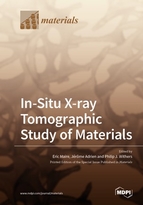In-Situ X-Ray Tomographic Study of Materials
A special issue of Materials (ISSN 1996-1944). This special issue belongs to the section "Advanced Materials Characterization".
Deadline for manuscript submissions: closed (31 December 2018) | Viewed by 75645
Special Issue Editors
Interests: materials science; X-Ray imaging; computed tomography; cellular materials
Interests: X -ray tomography; materials science
Special Issue Information
Dear Colleagues,
X-ray computed tomography has advanced significantly over recent years, both in terms of spatial resolution and image acquisition time. This has opened the way for a plethora of in situ studies, capturing a wide range of phenomena from the very quick to processes, which take place over many months. Many of the short timescale studies lie within the domain of synchrotron X-ray imaging with the longer timescales more focused on laboratory imaging.
Papers for this Special Issue of Materials, entitled "In-Situ X-Ray Tomographic Study of Materials" are invited that cover all aspects of in situ imaging from manufacturing processes (e.g., powder metallurgy, welding, solidification, additive manufacturing) to degradation under in operando service conditions (e.g., impact, tensile, corrosion, etc), from the perfusion of fluids through porous structures (e.g., fuel cells and batteries, petrological, bioscaffolds) to the behaviour of granular solids, across a very wide range of length and time scales, as well as materials. You are welcome to focus primarily on the in situ environments (thermal, mechanical, chemical, etc.) or on the phenomena that are being characterised and understood.
Full papers, communications, and reviews are all welcome.
Dr. Eric MaireDr. Jerome Adrien
Prof. Philip John Withers
Guest Editors
Manuscript Submission Information
Manuscripts should be submitted online at www.mdpi.com by registering and logging in to this website. Once you are registered, click here to go to the submission form. Manuscripts can be submitted until the deadline. All submissions that pass pre-check are peer-reviewed. Accepted papers will be published continuously in the journal (as soon as accepted) and will be listed together on the special issue website. Research articles, review articles as well as short communications are invited. For planned papers, a title and short abstract (about 100 words) can be sent to the Editorial Office for announcement on this website.
Submitted manuscripts should not have been published previously, nor be under consideration for publication elsewhere (except conference proceedings papers). All manuscripts are thoroughly refereed through a single-blind peer-review process. A guide for authors and other relevant information for submission of manuscripts is available on the Instructions for Authors page. Materials is an international peer-reviewed open access semimonthly journal published by MDPI.
Please visit the Instructions for Authors page before submitting a manuscript. The Article Processing Charge (APC) for publication in this open access journal is 2600 CHF (Swiss Francs). Submitted papers should be well formatted and use good English. Authors may use MDPI's English editing service prior to publication or during author revisions.
Keywords
- X-ray computed tomography (CT)
- In-situ experiments
- Synchrotron imaging
- laboratory imaging
- manufacturing processes
- material behaviour
Related Special Issue
- Materials Characterizations Using In-Situ Techniques in Materials (8 articles)








